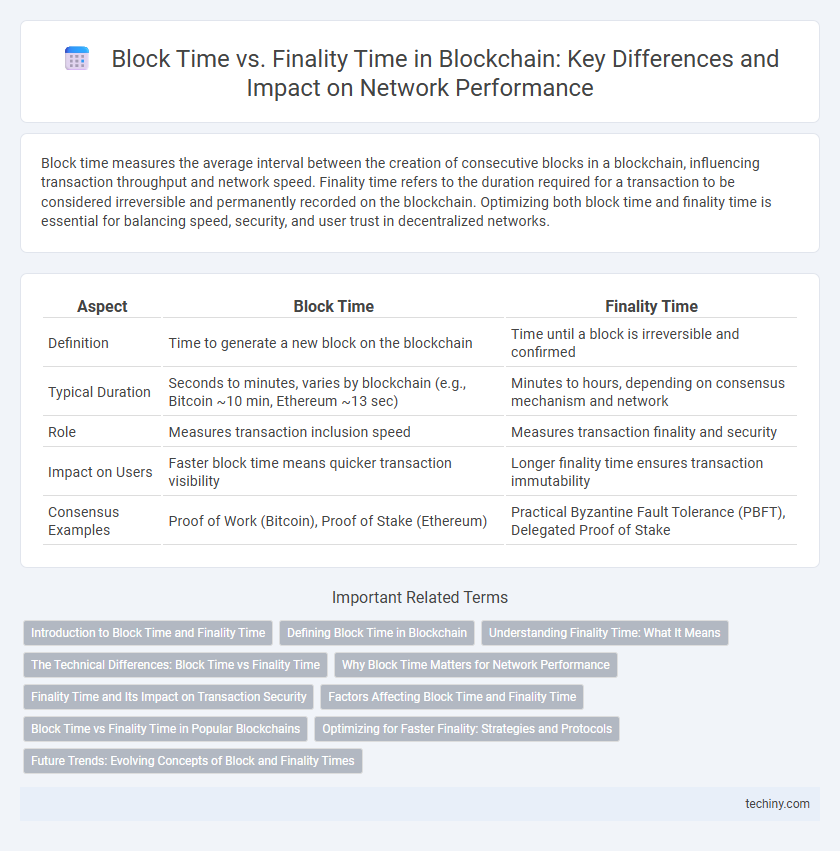Block time measures the average interval between the creation of consecutive blocks in a blockchain, influencing transaction throughput and network speed. Finality time refers to the duration required for a transaction to be considered irreversible and permanently recorded on the blockchain. Optimizing both block time and finality time is essential for balancing speed, security, and user trust in decentralized networks.
Table of Comparison
| Aspect | Block Time | Finality Time |
|---|---|---|
| Definition | Time to generate a new block on the blockchain | Time until a block is irreversible and confirmed |
| Typical Duration | Seconds to minutes, varies by blockchain (e.g., Bitcoin ~10 min, Ethereum ~13 sec) | Minutes to hours, depending on consensus mechanism and network |
| Role | Measures transaction inclusion speed | Measures transaction finality and security |
| Impact on Users | Faster block time means quicker transaction visibility | Longer finality time ensures transaction immutability |
| Consensus Examples | Proof of Work (Bitcoin), Proof of Stake (Ethereum) | Practical Byzantine Fault Tolerance (PBFT), Delegated Proof of Stake |
Introduction to Block Time and Finality Time
Block time refers to the average interval between the creation of consecutive blocks in a blockchain, typically measured in seconds or minutes depending on the consensus protocol. Finality time indicates the duration required for a transaction to be irreversibly confirmed and accepted across the network. Understanding the distinction between block time and finality time is crucial for assessing blockchain performance and transaction security.
Defining Block Time in Blockchain
Block time in blockchain refers to the average duration required to create a new block and add it to the blockchain ledger, typically measured in seconds. This metric is crucial because it influences transaction throughput and network latency, with examples like Bitcoin having an average block time of 10 minutes and Ethereum around 13-15 seconds. Faster block times can improve user experience by enabling quicker transaction confirmations but may increase the risk of orphaned blocks and network forks.
Understanding Finality Time: What It Means
Finality time in blockchain refers to the point at which a transaction is considered irreversible and permanently recorded on the distributed ledger. Unlike block time, which measures the interval between the creation of consecutive blocks, finality time ensures that transactions cannot be altered or reversed, providing security and trust in the network. Understanding finality time is crucial for applications requiring guaranteed transaction confirmation, such as financial settlements and smart contract execution.
The Technical Differences: Block Time vs Finality Time
Block time refers to the average duration it takes for a blockchain network to produce a new block, typically measured in seconds or minutes, influencing transaction throughput and update frequency. Finality time represents the period required for a transaction to be considered irreversible and confirmed on the blockchain, indicating the security and certainty of the transaction state. While block time affects the pace of block creation, finality time determines the confidence level users have that the recorded data will not be altered or undone.
Why Block Time Matters for Network Performance
Block time directly impacts network throughput and transaction confirmation speed, determining how quickly blocks are appended to the blockchain. Shorter block times enhance user experience by reducing waiting periods but may increase the risk of forks, affecting network stability. Optimizing block time is crucial for balancing transaction finality and overall network performance in blockchain systems.
Finality Time and Its Impact on Transaction Security
Finality time refers to the duration required for a blockchain transaction to become irreversible and securely embedded within the ledger, critically influencing transaction security by mitigating the risk of double-spending and chain reorganizations. Shorter finality times enhance user confidence and enable faster trustless transactions, essential for real-time applications like decentralized finance (DeFi) and supply chain tracking. Protocols such as Ethereum 2.0 and Algorand optimize finality by leveraging consensus mechanisms like Proof of Stake (PoS) and Byzantine Fault Tolerance (BFT), ensuring both scalability and transaction irrevocability.
Factors Affecting Block Time and Finality Time
Block time and finality time in blockchain are significantly influenced by network latency, consensus algorithm complexity, and block size limitations. Proof-of-Work chains like Bitcoin exhibit longer block times due to mining difficulty adjustments, while Proof-of-Stake networks can achieve faster finality through validator consensus mechanisms. Network congestion and transaction throughput also impact the variability and predictability of both block time and finality time across different blockchain protocols.
Block Time vs Finality Time in Popular Blockchains
Bitcoin's average block time is approximately 10 minutes with finality time extending up to an hour due to multiple confirmations required for security. Ethereum's block time is around 12 to 14 seconds, while its finality time varies between 1 to 2 minutes under the Casper consensus protocol. Popular proof-of-stake blockchains like Polkadot and Cardano achieve block times of 6 seconds and 20 seconds respectively, with finality times typically under a minute, highlighting faster transaction finalization compared to proof-of-work systems.
Optimizing for Faster Finality: Strategies and Protocols
Optimizing for faster finality in blockchain involves utilizing consensus protocols like Proof of Stake (PoS) and Practical Byzantine Fault Tolerance (PBFT), which significantly reduce block confirmation times compared to Proof of Work (PoW). Layer 2 solutions such as rollups and state channels enhance throughput and minimize latency, accelerating transaction finality without compromising security. Implementations like Ethereum 2.0 and Polkadot demonstrate these strategies by achieving near-instant finality, crucial for high-frequency trading and real-time applications.
Future Trends: Evolving Concepts of Block and Finality Times
Future trends in blockchain technology indicate a shift towards reducing block time while enhancing finality time to achieve faster, more secure transactions. Innovations like sharding and layer 2 scaling solutions are evolving the concepts of block and finality times by enabling near-instant transaction settlement and improved consensus mechanisms. These advancements are crucial for decentralized finance (DeFi) and enterprise adoption, where both speed and transaction finality are paramount.
Block Time vs Finality Time Infographic

 techiny.com
techiny.com